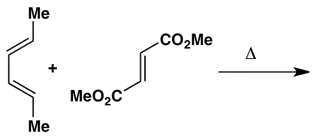Quiz Competition On Pericyclic Reactions

- 1.
Which of the following dienophiles is the most reactive with buta-1,3-diene?
- A.
Option 1
- B.
Option 2
- C.
Option 3
- D.
Option 4
Correct Answer
C. Option 3Explanation
Compound (c) is the dienophile with the best combination of low steric hindrance and a low-energy LUMO (which is caused by the electron-withdrawing anhydride residue)Rate this question:
-
- 2.
Which of the following dienes cannot undergo Diels-Alder reactions?
- A.
Option 1
- B.
Option 2
- C.
Option 3
- D.
Option 4
Correct Answer
D. Option 4Explanation
A diene has to be able to assume an s-cis conformation in order to undergo Diels-Alder reactions, and (d) has a constrained s-trans structureRate this question:
-
- 3.
Which of adducts (a)-(d) is the main product of the following Diels-Alder reaction?
- A.
Option 1
- B.
Option 2
- C.
Option 3
- D.
Option 4
Correct Answer
B. Option 2Explanation
The relative configurations of the diene and dienophile are preserved in the concerted syn addition of a Diels-Alder reaction. For the stereochemistry of Diels-Alder reactionsRate this question:
-
- 4.
Which of the following is the main product in the ozonolysis of 1,4-dimethylcyclohexene followed by a reductive workup with Zn and ethanoic acid?
- A.
Option 1
- B.
Option 2
- C.
Option 3
- D.
Option 4
Correct Answer
C. Option 3Explanation
The products of ozonolysis followed by a reductive workup are aldehyde(s) and/or ketone(s). Note the position of the methyl substituent in the ring-opened product. For ozonolysis of alkenesRate this question:
-
- 5.
Which of the following is the main product in the ozonolysis of 1,5-dimethylcyclohexene followed by a workup with aqueous H2O2?
- A.
Option 1
- B.
Option 2
- C.
Option 3
- D.
Option 4
Correct Answer
C. Option 3Explanation
The products of ozonolysis followed by an oxidative workup are carboxylic acid(s) and/or ketone(s). Note that the position of the methyl substituent in the ring-opened product. For ozonolysis of alkenesRate this question:
-
- 6.
Which of phenols (a)-(d) is the main product of the following thermal rearrangement?
- A.
Option 1
- B.
Option 2
- C.
Option 3
- D.
Option 4
Correct Answer
D. Option 4Explanation
The reaction is a Claisen rearrangement which is a type of [3,3] sigmatropic rearrangementRate this question:
-
- 7.
Which of the following reactions is not thermally allowed?
- A.
Option 1
- B.
Option 2
- C.
Option 3
- D.
Option 4
Correct Answer
A. Option 1Explanation
For some orbital symmetry controlled reactions, see pp. 478-5. Reaction (a) is a [2+2] cycloaddition, (b) a [3,3] sigmatropic rearrangement, (c) an electrocyclic reaction, and (d) an ene reaction.Rate this question:
-
- 8.
Which of the following reactions is classified as an ene reaction?
- A.
Option 1
- B.
Option 2
- C.
Option 3
- D.
Option 4
Correct Answer
D. Option 4Explanation
Reactions (a) and (b) are both [3,3] sigmatropic rearrangements, (c) an electrocyclic reaction, and (d) an ene reaction.Rate this question:
-
- 9.
The following involves two pericyclic reactions. Which combination indicates correctly the types of reaction involved?
- A.
[4+2] cycloaddition + [2+2] cycloreversion
- B.
Cheletropic reaction + [4+2] cycloaddition
- C.
[4+2] cycloaddition + [4+1] cycloreversion
- D.
[4+2] cycloaddition + cheletropic reaction
Correct Answer
D. [4+2] cycloaddition + cheletropic reactionExplanation
Carbon monoxide is lost from the intermediate adductRate this question:
-
- 10.
Which of the following is classified as an electrocyclic reaction?
- A.
Option 1
- B.
Option 2
- C.
Option 3
- D.
Option 4
Correct Answer
A. Option 1Explanation
Electrocyclic reactions involve the cyclization of a conjugated polyene, where a pi bond is formed by the overlap of two p orbitals from adjacent atoms. This is exactly what happens in Option 1. The conjugated diene rearranges to form a cyclobutene ring with a new sigma bond between the two carbons that were originally part of the double bonds.Rate this question:
-
Quiz Review Timeline +
Our quizzes are rigorously reviewed, monitored and continuously updated by our expert board to maintain accuracy, relevance, and timeliness.
-
Current Version
-
Feb 19, 2024Quiz Edited by
ProProfs Editorial Team -
Apr 21, 2020Quiz Created by
Ashok Pise





